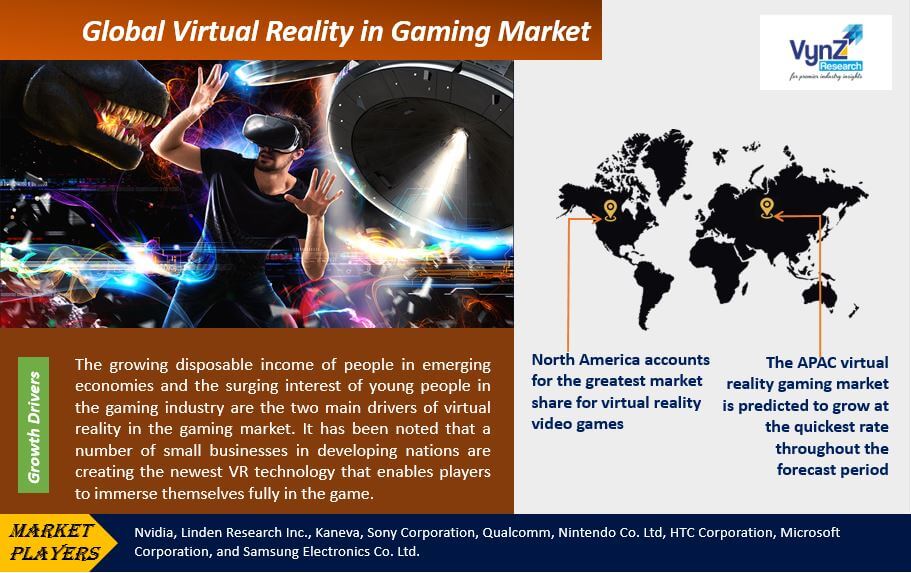| Status : Published | Published On : Apr, 2024 | Report Code : VRICT5076 | Industry : ICT & Media | Available Format :

|
Page : 176 |

Global Virtual Reality in Gaming Market – Analysis and Forecast (2025-2030)
Industry Insights by Components (Hardware and Software), by Compatibility (Gaming Consoles, PCs and Mobile Devices)
Industry Overview
The global virtual reality gaming market size is expected to grow from USD 20.2 billion in 2023 to USD 58.6 billion by 2030, at a CAGR of 16.0%. This growth is mainly attributed to the growth in the entire virtual gaming industry during the forecast period. In turn, the growth of VR in the gaming industry is mainly due to the launch of several new gaming devices as well as the significant rise in the disposable income of people.
Virtual Reality, or VR provides a more impressive gaming experience, creating an interactive world with the help of computers. The use of different tools enhances the graphics presentations, thereby creating a real-life-like setting. The experience is further enhanced by combining virtual and auditory feedback and the physical occurrence of the gamers is protected with different stimulus applications.

The technique known as virtual reality provides users with an immersive, interactive world in a computer-generated setting that is further enhanced in accordance with the graphic requirements of a certain game. It is been noted that virtual reality technology in the gaming industry combines auditory and virtual feedback to let players immerse themselves in a made-up world where, through the application of a stimulus, the physical occurrence of players is safeguarded.
Virtual Reality in Gaming Market Segmentation
Insight by Components
According to the different components, the global virtual reality gaming market can be divided into hardware and software.
Out of these two, the hardware category is expected to grow at a faster rate than the other during the forecast period due to increased availability and easy accessibility to a wide array of VR accessories and gear all over the world. Apart from that, there will be also a wide range of gadgets developed and made available, such as masks, gloves, bodysuits, VR hands, backpacks, and more.
Insight by Compatibility
According to the compatibility, the virtual reality gaming market can be divided into personal computers, mobile devices, and gaming consoles.
Among all these three categories, the gaming consoles category is expected to be the largest contributor during the forecast period. This is attributed to its useful features, such as low-cost, lightweight, minimal hardware upgrade requirements, and no technical expertise requirements.
Global Virtual Reality in Gaming Market Report Coverage
|
Report Metric |
Details |
|
Historical Period |
2018 - 2023 |
|
Base Year Considered |
2024 |
|
Forecast Period |
2025 - 2030 |
|
Market Size in 2024 |
U.S.D. 20.2 Billion |
|
Revenue Forecast in 2030 |
U.S.D. 58.6 Billion |
|
Growth Rate |
16% |
|
Segments Covered in the Report |
By Components, and By Compatibility |
|
Report Scope |
Market Trends, Drivers, and Restraints; Revenue Estimation and Forecast; Segmentation Analysis; Impact of COVID-19; Companies’ Strategic Developments; Market Share Analysis of Key Players; Company Profiling |
|
Regions Covered in the Report |
North America, Europe, Asia-Pacific, Middle East, and Rest of the World |
Industry Dynamics
Virtual Reality in Gaming Market Growth Drivers
The growth of the global virtual reality gaming market is mainly attributed to the higher disposable income among people, especially in developing countries. In addition, the young generation has an immense interest in the gaming industry, which also drives its growth.
Moreover, a large number of small companies in these developing nations are now creating and implementing new VR technology into the gadgets that offer more immersive gaming experiences to the players.
Implementation of the VR technology also allows the gamers to make adjustments according to their preferences to the simulated setting to suit their needs. This has also resulted in the growth of the global virtual reality gaming market.
Most importantly, the rising interest and inclination towards VR gaming among people has propelled the growth of the global virtual reality gaming market. This rise in interest is the consequence of several factors, such as technological developments, higher investment in VR development, demand for more immersive gaming experiences among people, and more.
All these factors have encouraged companies like HTC, Sony, and Oculus to come up with more advanced and functional VR headsets of high quality, which has increased the adoption rate of VR gaming among people to have a more realistic gaming experience.
Virtual Reality in Gaming Market Challenges
The growth of the global virtual reality gaming market is somewhat hindered by the high cost of the gear as well as little awareness about the technology among the people. However, a lot of gaming clubs are set up by VR game suppliers to overcome this obstacle to reach their target demographic and propel market growth.
Virtual Reality in Gaming Market Industry Ecosystem
New products with more creative solutions are created by the players in the virtual reality gaming industry to make VR gaming more affordable. The vendors are providing multiple options to offer a better gaming experience as well.
The development of supporting technologies for VR gaming, such as haptic feedback devices, motion tracking, and room-scale tracking systems are also helping the VR gaming ecosystem a lot. These advanced technologies allow gamers to move physically within the virtual environment for a better tactile feeling and a more immersive and interactive gaming experience.
Virtual Reality in Gaming Market Geographic Overview
North America is the largest contributor to the global virtual reality video gaming market and is expected to hold its position during the forecast period. This is mainly due to the widespread use of video games among the young generation and the growth of the gaming industry in the region. Apart from that, this region houses some of the major developers of VR games who are putting in more effort and emphasis on creating more VR-compatible games.
However, the APAC countries are also contributing to the global virtual reality gaming market quite fairly, which is mainly due to the higher population in these countries and the widespread acceptance of VR gaming technology. During the forecast period, this is expected to grow even at a much faster rate. Also, the role of the official gaming influencers is to help these companies grow along with the global virtual reality gaming market by promoting the use of VR headsets for more immersive gaming experiences.
Virtual Reality in Gaming Market Competitive Insight
A wide consumer base is being engaged by the introduction of new products by major participants in the virtual reality gaming sector. For instance, Sony Corporation introduced a new headset in 2016 that targets both potential new customers and existing ones, whose number is increasing rapidly.
Some of the major players operating in the global virtual reality in gaming market include Nvidia, Linden Research Inc., Kaneva, Sony Corporation, Qualcomm, Nintendo Co. Ltd, HTC Corporation, Microsoft Corporation, and Samsung Electronics Co. Ltd.
Recent Development by Key Players
Sony has invested 300 billion yen into the field of ‘extended reality’.to help bridge the gap between physical and digital worlds. This will account for 40% of the company’s 760 billion yen research and development budget for the year, surpassing spending on electronics and semiconductors.
Qualcomm Inc. (QCOM) has launched a new chip designed for virtual reality (VR) and augmented reality (AR), with Google LLC (GOOGL) and Samsung Electronics Co. The new Qualcomm chip could help the companies compete with Apple Inc. (AAPL) and Meta Platforms Inc. (META) in the VR and AR headset arena that builds upon the Snapdragon XR2 Gen 2.
The virtual reality gaming market report offers a comprehensive market segmentation analysis along with an estimation for the forecast period 2025–2030.
Segments Covered in the Report
- By Components
- Hardware
- Software
- By Compatibility
- Personal Computers
- Game Consoles
- Mobile Devices
Region Covered in the Report
- North America
- U.S.
- Canada
- Mexico
- Europe
- Germany
- U.K.
- France
- Italy
- Spain
- Russia
- Rest of Europe
- Asia-Pacific (APAC)
- China
- Japan
- India
- South Korea
- Rest of Asia-Pacific
- Rest of the World (RoW)
- Brazil
- Saudi Arabia
- South Africa
- U.A.E.
- Other Countries
.png)
Source: VynZ Research
Frequently Asked Questions
Purchase Options
Latest Report
Research Methodology
- Desk Research / Pilot Interviews
- Build Market Size Model
- Research and Analysis
- Final Deliverabvle
Connect With Our Sales Team
- Toll-Free: 1 888 253 3960
- Phone: +91 9960 288 381
- Email: enquiry@vynzresearch.com
Virtual Reality in Gaming Market
